The Economics and Statistics Division maintains archives of previous publications for accountability purposes, but makes no updates to keep these documents current with the latest data revisions from Statistics Canada. As a result, information in older documents may not be accurate. Please exercise caution when referring to older documents. For the latest information and historical data, please contact the individual listed to the right.
<--- Return to Archive
For additional information relating to this article, please contact:
January 07, 2022LABOUR FORCE SURVEY: VISIBLE MINORITIES, DECEMBER 2021 Starting with July 2020, Statistics Canada has added a question to the Labour Force Survey asking respondents about whether they identify with visible minority populations. The population group categories of response are the same as those found in the 2016 Census: White, South Asian (e.g., East Indian, Pakistani, Sri Lankan), Chinese, Black, Filipino, Arab, Latin American, Southeast Asian (e.g., Vietnamese, Cambodian, Laotian, Thai), West Asian (e.g., Iranian, Afghan), Korean, Other.
Labour force characteristics for Indigenous populations are reported separately in the Labour Force Survey.
This analysis will focus on conditions reported by respondents for December 2021 and year-over-year changes from December 2020. Results are not seasonally adjusted. Unless otherwise indicated, data refer to populations aged 15-69.
December 2021
Nationally, the unemployment rate of those who identify with a visible minority population (6.5%) was higher than the unemployment rate (4.7%) of those that did not identify as Indigenous or in a visible minority population. The unemployment rate for those who identify with a visible minority group was higher than for those who did not identify as Indigenous or in a visible minority population in all regions except for Atlantic Canada, Manitoba, and Alberta. This gap was highest in Ontario and only marginal in British Columbia. In Atlantic Canada, the unemployment rate was 7.5% for those that identify with a visible minority group. This was 0.6 percentage points lower than those that did not identify as Indigenous or in a visible minority population.

National participation rates were higher for those who identify with a visible minority population (75.8%) than for those that did not identify as Indigenous or in a visible minority population (74.3%). Participation rates of those who identify with a visible minority population were higher in all regions with the exception of Ontario. In Atlantic Canada, those who identify with a visible minority population reported an 73.1% participation rate, compared to a 70.3% participation rate for those that do not identify as Indigenous or in a visible minority population.
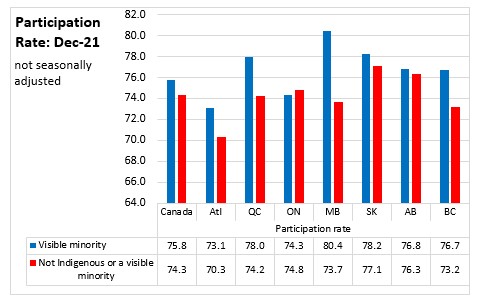
Nationally, employment rates were slightly higher for those who identified with visible minority populations (70.9%) than for those who did not identify as Indigenous or in a visible minority population (70.8%). In Ontario, and Saskatchewan, employment rates were lower for visible minority populations than for those who do not identify as Indigenous or in a visible minority population. Employment rates were higher for those who identify with visible minority populations in Atlantic Canada, Quebec, Manitoba, Alberta and British Columbia when compared against those who do not identify as Indigenous or in a visible minority population. The gap between the employment rates for those who identified with visible minority populations and those who did not was highest in Manitoba.

Unemployment rates were higher across almost all visible minority populations than for those who did not identify as Indigenous or in a visible minority population. The exception is among South Asian men and Filipino women. (Some of the results for unemployment rates have limited data quality and should be used with caution).
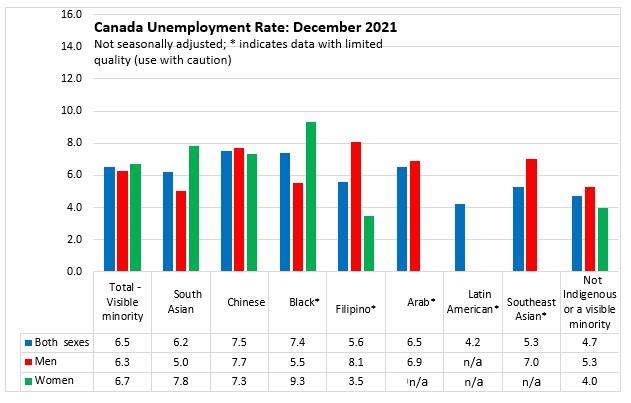
Labour force participation rates for those identifying with a visible minority was higher when compared those who do not identify as Indigenous or a visible minority. Among those that identified with specific visible minority populations, participation rates were highest among Latin American men and Filipino women. Participation rates among women were notably lower than among men for people who identified as Chinese, Arab, Latin American and Southeast Asian.
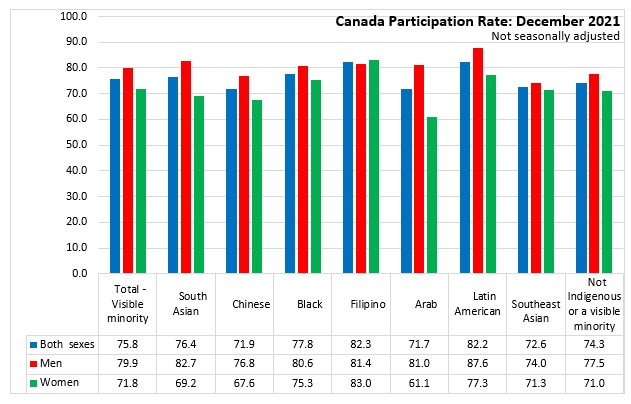
Employment rates among those who identify as a visible minority were slightly above those who do not identify as Indigenous or a visible minority. Women in many visible minority populations had lower employment rates than men, particularly where lower participation rates and higher unemployment rates were observed. The exception was among women who identify as Filipino.

Unemployment rates were higher for all age cohorts of visible minority populations, when compared with those that do not identify as Indigenous or in a visible minority population.

Participation rates of visible minority populations were higher for older workers, compared to the same age cohort that does not identify as Indigenous or visible minority populations. Among youth and core aged workers, participation rates among visible minority populations were lower than among similarly-aged populations that do not identify as Indigenous or in a visible minority population.
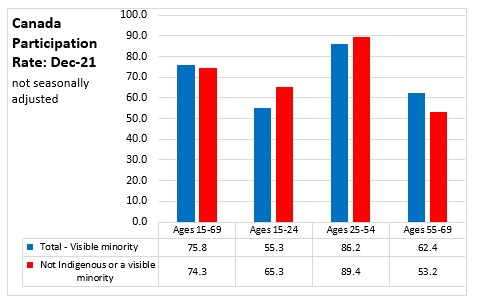
With lower participation and higher unemployment rates, employment rates were lower for visible minority youth and core aged populations. With stronger participation rates (and despite higher unemployment rates), the employment rate of older visible minority populations was higher than older Canadians who do not identify as Indigenous or in a visible minority population.
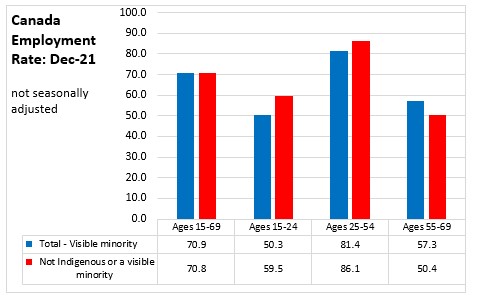
Year-over-Year Change (December 2020 vs December 2021)
Nationally, the unemployment rate among those who identify as visible minority populations declined from 10.0% in December 2020 to 6.5% in December 2021. All regions reported declines in visible minority population unemployment rates when compared to the previous year, with the largest decline in Alberta.
The unemployment rate among Canadians who do not identify as Indigenous or in a visible minority population also declined from 7.2% in December 2020 to 4.7% in December 2021. All regions reported declines in unemployment rates among those that do not identify as Indigenous or in a visible minority population from a year earlier.
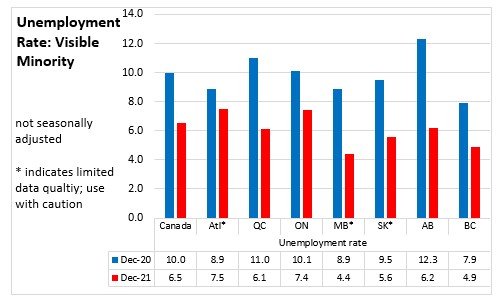

Participation rate among Canadians who identify as a visible minority increased from 74.3% in December 2020 to 75.8% in December 2021. Participation rates among visible minority populations were lower when compared to the previous year in Atlantic Canada. Nationally, participation rate among those who do not identify as Indigenous or in a visible minority population increased slightly from 74.2% in December 2020 to 74.3% in December 2021 with gains in all regions except British Columbia.
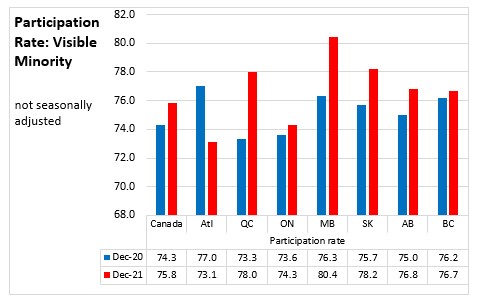
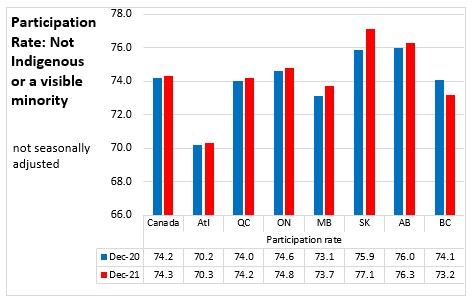
Employment rates among Canadians who identify as a visible minority population increased 4.0 percentage points from a year earlier to 70.9% in December 2021. All regions except Atlantic Canada reported gains in employment rates of visible minority populations. Employment rates among Canadians who do not identify as Indigenous or in a visible minority population increased 2.0 percentage points from a year earlier to 70.8% in December 2021.
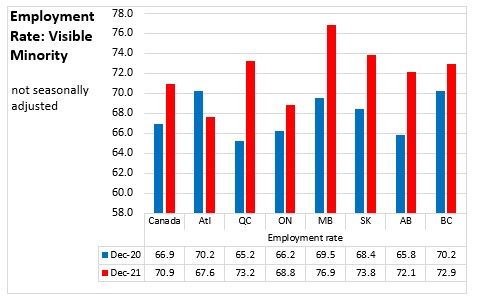
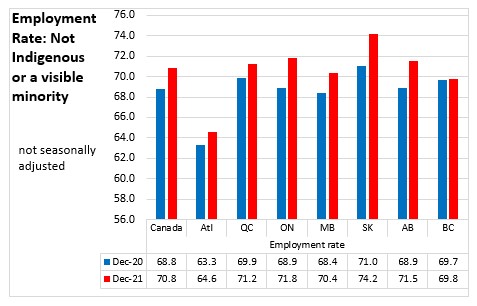
Unemployment rates across all visible minority populations were lower in December 2021 when compared to a year earlier. Unemployment rates among both men and women visible minority populations also declined from the previous year. Unemployment rate for December 2021 was not available for Latin American men and Arab, Latin American and Southeast Asian women.
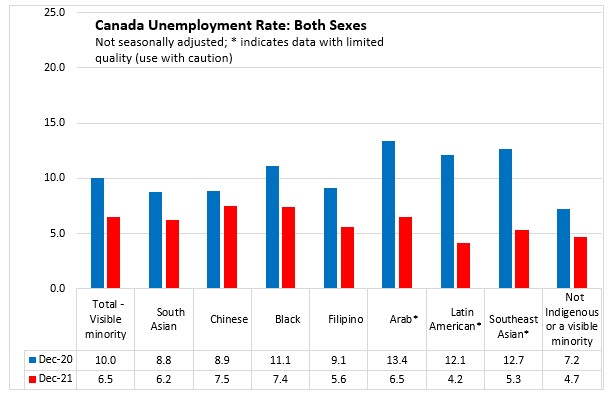
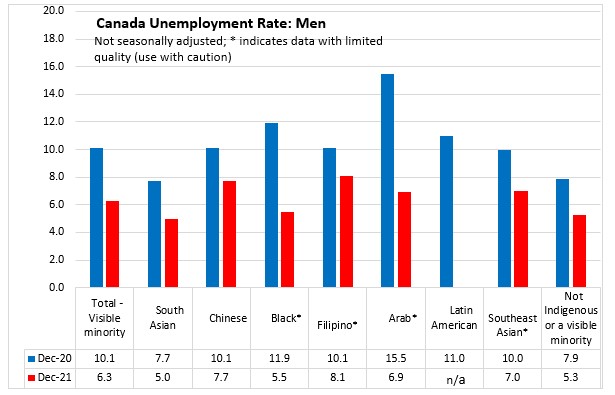
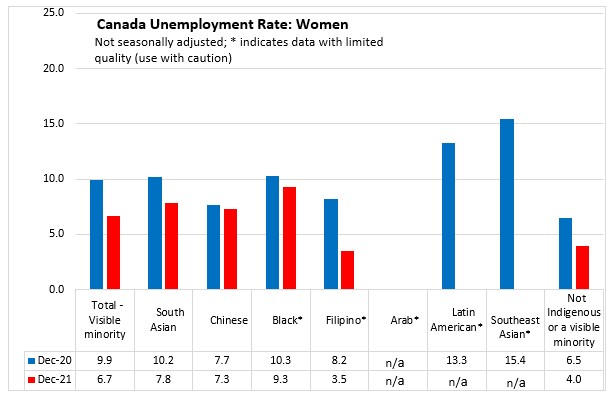
Participation rate among all visible minority population groups increased year-over-year in December 2021. Among men, year-over-year participation rates fell among those who identify as South Asian, Filipino and Southeast Asian.
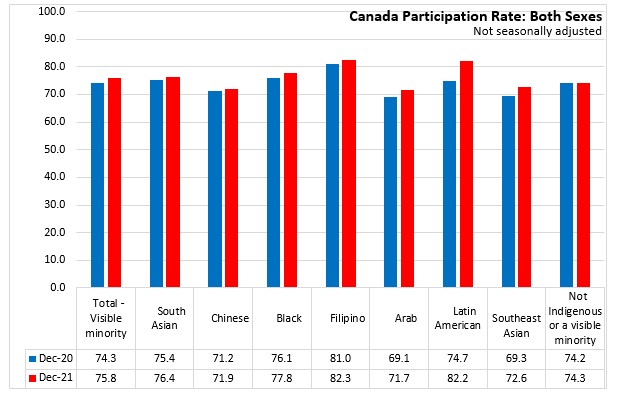
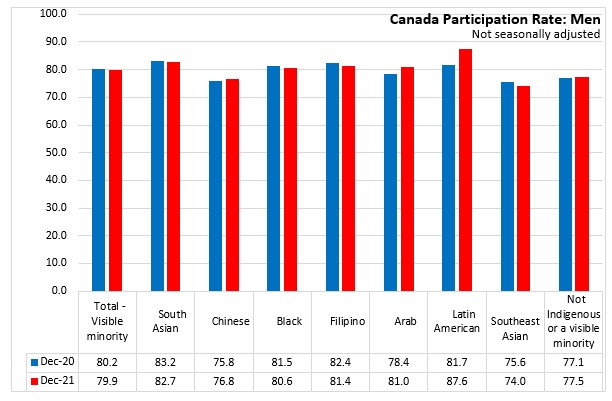
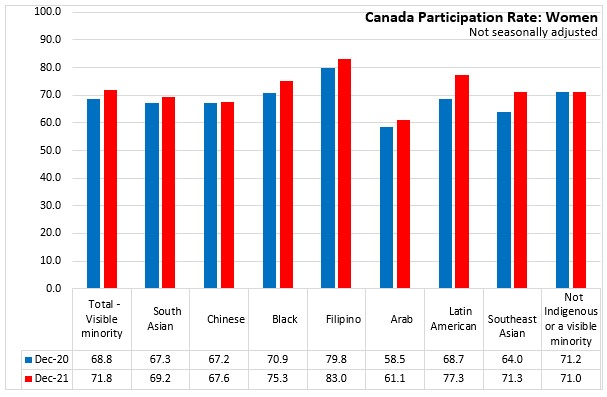
Employment rates across most visible minority groups increased year-over-year in December 2021. Both men and women reported gains in employment rates when compared to the previous year.
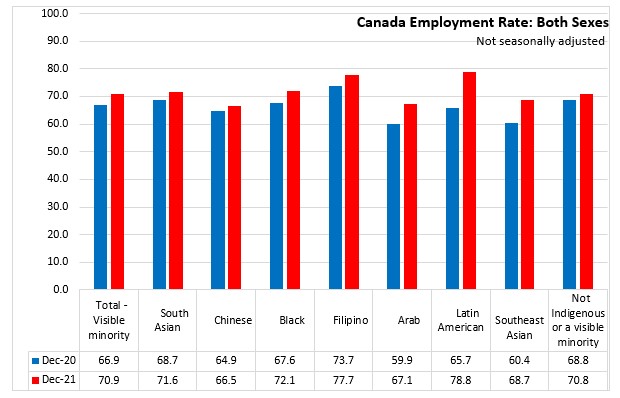
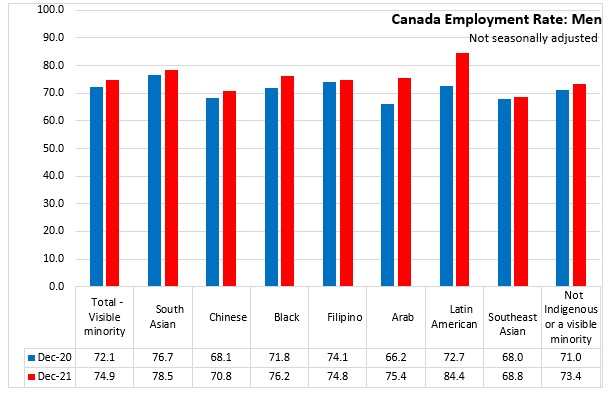
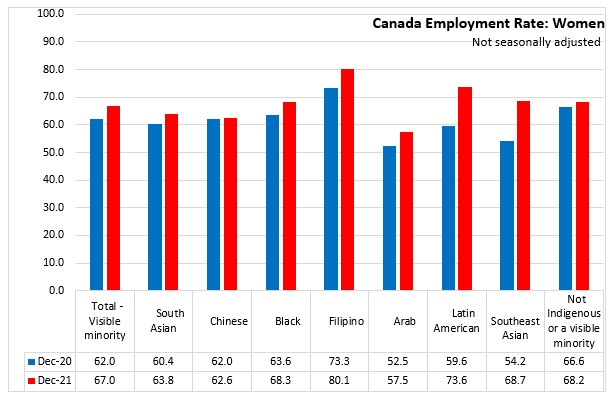
Unemployment rate of visible minority populations declined year-over-year for all age groups. Unemployment rates for those who do not identify as Indigenous or in a visible minority population were also lower across all age groups from a year earlier.
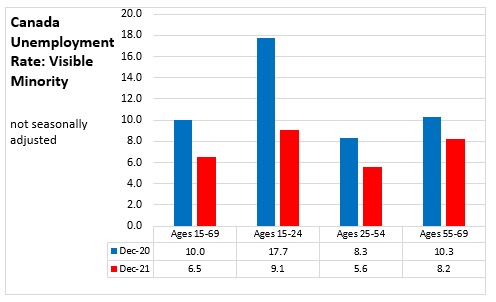

Participation rate of visible minority populations increased year-over-year for all age groups. Participation rates among those who do not identify as Indigenous or in a visible minority population increased year-over-year increased for youth and core-aged workers but declined for older workers.
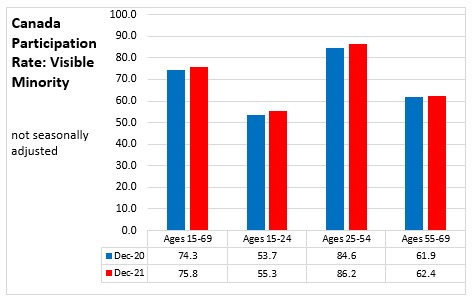
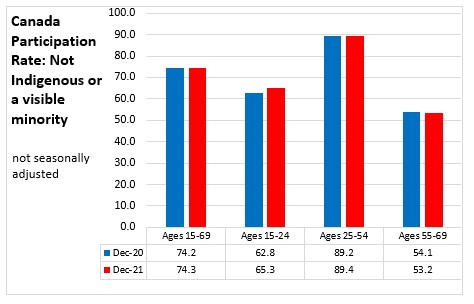
Employment rates of visible minority populations increased year-over-year across all age cohorts. The same trend occurred for those who do not identify as Indigenous or in a visible minority population.
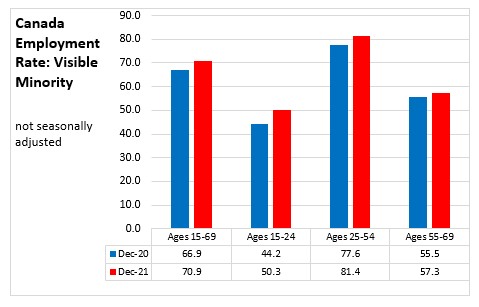
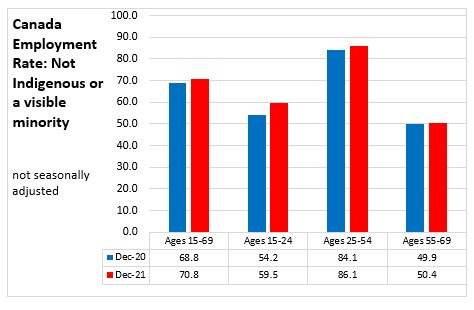
Source: Statistics Canada, Labour Force Survey, December 2021
<--- Return to Archive